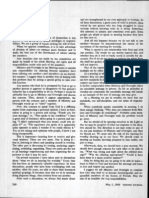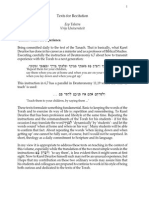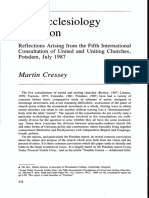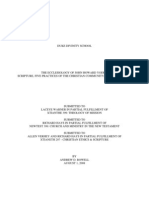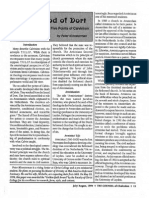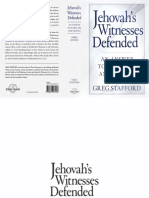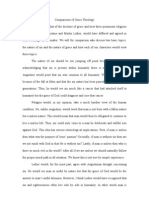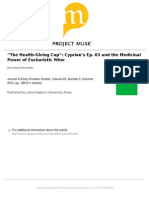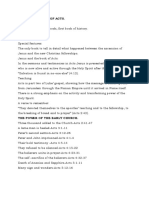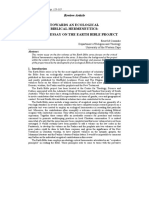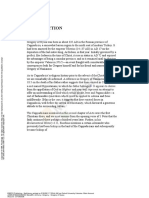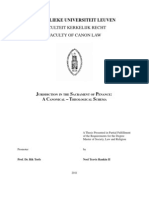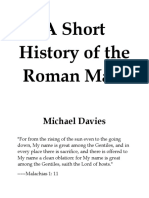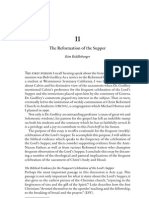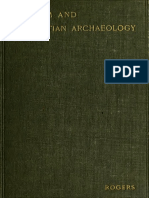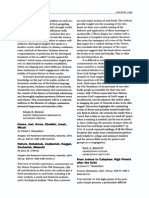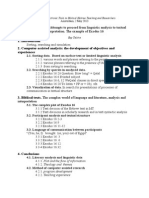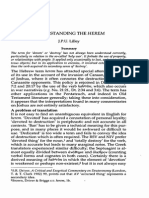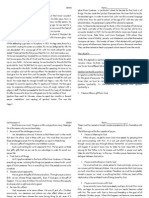The Origin and Nature of The Church - Johnston PDF
The Origin and Nature of The Church - Johnston PDF
Uploaded by
Andy EspinozaCopyright:
Available Formats
The Origin and Nature of The Church - Johnston PDF
The Origin and Nature of The Church - Johnston PDF
Uploaded by
Andy EspinozaOriginal Description:
Original Title
Copyright
Available Formats
Share this document
Did you find this document useful?
Is this content inappropriate?
Copyright:
Available Formats
The Origin and Nature of The Church - Johnston PDF
The Origin and Nature of The Church - Johnston PDF
Uploaded by
Andy EspinozaCopyright:
Available Formats
Chapter I
The Origin and Nature
of the Church
Robert M. Johnston
Introduction
e church is a paradox. It appears enfeebled and defective, yet God
works in it. 1 On one hand the church in all ages has been an arena where
countless persons have been saved and transformed, where dedicated
men and women have devoted their lives to unselfish service to God and
humanity, and where the highest ideals of human history have been enshrined
and cherished. On the other hand the church in every age has been the scene
of obscene cruelty and viciousness, of self-serving power struggles and corruption, of hypocrisy and sanctimoniousness. 2 As the bride of Christ3 the
church at times has been an unfaithful wife.
The reason for this paradox, of course, is that the church has both a divine
and human aspect It was raised up by God, but it consists of human beings.
Therefore, the performance of the church can be both disappointing and
inspiring, just like the performance of individual Christians-like the one who
is writing or reading this chapter!
One way to understand any institution, such as the church, is to go back
to its origins in an attempt to discover the original intention for it. The church
began in Bible times, so our principle source will be the Bible,4 to which we
will need to address a number of questions. How was the church, as founded
1 EllenO. White, TheActsoftMApostus(Mounl.ain View,CA, 1911), 12.
2 Even the Apooolic Age cannot be exempted from thia indictment, u any open-eyed reading of Paul's
Corinthian CO!TCipondence will conflllll. cr. Ellen White, The Great ConJroversy Between Christ
andSatan(Mountain View, CA, 1888, rev. ed. 1911), 43: "Even in her best estate the chun:h was not
composed wholly oftbe true, pure, and sincere."
3 Cf. Eph .S:23-2.S; 2 Cor 11:2.
4 Unleas otherwise noted, the English translation cited will be the Revised Standard Version.
The Origin and Nature of the Church
in the NT age, related to God's people in the OT, 5 to Judaism, and to the kingdom
of God which Jesus proclaimed? How did the church begin, and what were its
antecedents? How was it constituted, and who belonged to it? What was its
nature and self-understanding?<'
God's People in the Old Testament
Almost from the beginning of mankind God has successively called out
people from the disobedient, larger masses ofhumanity: Seth, Noah, Abraham,
Isaac, Jacob.7 Out of Egypt He called Israel, His "son" (Hos 11: 1), and He
made a special covenant with them.
The people of Israel fell into apostasy and broke the covenant Even so,
God counted them as His people, for the sake of the promises He had made to
their ancestors. But they split into two kingdoms, of which the northern one
fell to the Assyrians and virtually disappeared, and most of the people in the
southc;m one eventually went into Babylonian captivity. Of these a remnant
returned to the land of Israel.
There were always faithful believers, and their prophets foretold a time when
S In ccnnoction with tbia qucation it ia neceuary to explain clearly bow the word "church" ia used in tbia
llticle, ainco there .-e tbON who wiah to apply it to Ood 'a poop1e in the OT. The l.uer view ia obviously
1111Dadvoniam, u ia plain from M.U 16:18, where Jea111 apob in the future tenae: ''On thia rock I
will build (OI'kodomiiO) my church." It ia true that the tenn .Jckli.ria, u noted below, ia equivalent to
tho Hebrew qOhiiJ, the auembly of Ood 'a people in OT times, 1hua giving expreuion to the church 'a
understanding of itself u being in continuity with old Israel. It ia a1ao true that the apottle Paul and
othcn could aoe the ancient people ofOod in Scriptwe 11 a metapborica1 prefiguration of the church.
(On thia aoe Richard B. Haya, Echou o{Scripnuw in tiN 1Attr1 o{Paul [New Haven, 1990).) But
while we mua acknowledge that Ood haa had a people in every age, and that one can apeak
metapbcricaJJy of latael u "the church" and even u proleptic "Christian~" befCR the Incarnation,
it only crclllel IIUichroniatic confuaion 10 to apeak in an llticle of thia kind, where such language is
in danger of being undcmood in 111 ontological and litcralacrwe. Let the reader keep thia point fundy
fixed in mind u he reads thia chapter.
6 The anawcn to auch qucttiona camot always be aimplc and atraightforward, becaaae the ahapc of the
church wu different in different lima and different placca. The reader ahould be aware, therefOR,
that thia aln'ey cannot avoid being aclcctive and often overiy aimplc. Method ia another problem.
Some NT thoologica follow a atrictly topical outline, while othera examine the teachings of each NT
author or corpua, th111 avoiding the danger of homogenizing aomething which ia really diverse, and
making more visible chronological development. But if the latter approach ia taken, further qucationa
surface. The oldcat writinga in the NT are probably tbON of the apostle Paul. But tho Gospels and
Acta, though thcmaelvea written later, report evcnta and teachings which prcccded the ministry of
Paul. To further complicate the picture, when the Gospel writcn record the works ll1d tcachinga of
Jeaua, they have aclectcd them (cf. John 21:25) and preaentcd them in auclt a way u to meet the
spiritual needs of the church in the time in which they wrote. This llrticle will compromise between
the topical and the booko(:hronological approach. It will be organized around the key iaauea, but under
each isaue an attempt will be made to distinguish between the variOUI NT writcn when it ia necessary
to do 10.
7 Cf. Frank Stagg, New Testament Theology (Nashville, 1962). 171.
The Origin and Nature of the Church
God would again reign through His Anointed One, the Son of David. One prophet
spoke ofa new covenant God would make with His people, under which all would
be forgiven and receive instruction directly from the Lord (Jer 31 :31-34).
Ultimately, the mantle of the chosen remnant came to rest on one Person, 8
God's real Son (Matt 2:15, citing Hos 11: 1), as we shall see. It is at this point
that the Christian church of the NT enters the picture.
Terminology
Hebrew Words
In the OT the usual Hebrew words to designate a gathering of God's people
were 'edah and qliliii/. 9 'E@h could refer to the people even when they were
not assembled (as in Num 31: 16), but qlihz11 usually designated an assembly
(as in Deuteronomy 5:22). Expressions like "the congregation of the Lord" or
''the assembly oflsrael," as Jay succinctly summarizes, designated "a people
called into being by God, who from time to time are gathered together for such
solemn religious occasions as the receiving of the law (Deut 5:22), the
dedication of Solomon's Temple (l Kings 8: 14ff.), and the reading of the book
of the Law by Ezra (Nehemiah 8:2). "10
Greek Words
When the Hebrew Bible was translated into Greek (the Septuagint version),
'"tdlJh was everywhere translated by the word sunagog-e, but qlihlJ/ was sometimes
translated by sunagoo (in Genesis through Numbers and the prophets) and
sometimes by ekk~sia (in Deuteronomy, the historical books, and Psalms).
Both of these Greek words were available for use as the self-designation
of the Christian church, but sunagoge is used for a Christian assembly only
once in theW (Jas 2:2).11 It was also so used by the early second century
Christian writer Ignatius.l2 The word which came to be the term of choice in
the Christian church was ekldesia.13
81bid.
9 More eldcnaivc discusaion of these philological ddaila can be found in many of the atandard refenmce
worb, auch as in Gerhard Kitte~ cd., TDNT. trans. Geoffrey W. Bromilcy (Grand Rapids, 1979), a. v.
"ekkluia, " by K. L Schmidt; Eric G. Jay, The Church: Its Changing Image Through Twenty
Centuries (Atlanta, 1978), S-9; Colin Brown, cd., TIN NtiW lnternattona/Diclionary o[New Testament
Theology (Grand Rapida, 1979), a.v. "Church, Synagogue," by L Coenen.
10 Jay, 6.
II Some acholan think the term in Rev 2:9 and 3:9, "synagogue of Satan," refen to Christian heretica,
but this iJ quite uncertain.
12 Ignatius, ToPolycarp 4.2.
13 The English word "church" (and the German Kirche, Dutch ker/c) actually derives from yet another
The Origin and Nature of the Church
There may have been severnl reasons for this choice. Apparently Christians wanted to distinguish their meetings from those of the Jews, who
consistently used the word sunagoge for their assemblies and meeting houses.
But another reason might have been that the ever more numerous Gentile
believers were well acquainted with the term elddesia. It was used in Greek
cities like Athens for an officially summoned body of citizens, called out and
called together to conduct official business.1 4
New Testament use of eklesia. The word elddesia is used in the NT in
several senses. 15 Paul employs it with three levels of meaning:
1. He could designate as a church the Christians assembled in a particular
place, a local congregation (as in the house churches mentioned in Philemon
2 and Col4: 15).
2. He could refer to all the Christians in a city, such as the church of the
Thessalonians (1 Thess 1: 1). He sometimes used the plural to include all the
churches in a region ( 1 Thess 2: 14, Gal 1:2).
3. He could use the singular to refer to all Christians everywhere (Gal
1:13).
While it was true that the total world church (ekk/esia) was made up of
many local congregations (ekkllsiai), it was also true that the whole ekkllsia
(singular) was found represented in each place.1 6 These shades of meaning are
also found elsewhere. The universal church seems to be meant in Matthew
16:18 and the local church in Matthew 18:17.
Other expressions. Ekkllsia was not the only expression which the church
used to refer to itself. The NT is replete with metaphors and phrases such as
the "saints" (1 Cor 1:2), ''the believers" (Acts 2:44, NIV), "servants [ofthe
Lord]" (Acts 4:29), "the Israel of God" (Gal6: 16), "the household of God"
(1 Pet 4: 17), the "body" (Rom 12:4-5), "God's temple" (1 Cor 3: 10-17), "the
flock of God" (1 Pet 5:2), and dozens ofothersP
Greek word. kurialci. 1n adjective meaning "of the Lord." The expreuion, filled out, referred to the
aaaembly of the Lord or the hot.e of the Lord. Elclclitia, oo the other hand, ia the origin of the word
for ctu.n:b in the Romance languages (Sp1111iab igletia, French iglise, Italian chie1a).
14 Too much bu boen made of the etymology of the word, placing theologicalaigniftcance on the fact that
it derives from ekkakO, to call out. Obvioully the pag1n Greeb who invented the wooi nev intended
a theological content The word aimply me1n1 "In asacmbly," called out to meet, not called out from
the world.
IS See Jay, 7-9; Schmidt, TDNT. s. v. "ekkle.Jia ";etc.
16 See the argument in Schmidt, 504-S.
17 Tbcae expreuiona lll'ld metaphon are diacuucd lit length in auch workJ u Ethelbert Stauffer, New
TestCliMnt Theology, tranl. John Marsh (New York, 1955), 153-57; PaulS. Minear, "Church, Idea
of," in /DB. cd. George Arthur Buttrick, vol. I (New York. 1962), 607-17; PaulS. Minear, Images
of the Church in the New Testament (Philadelphia, 1960); Ralph P. Martin, The Family and the
Fellowship: New Testament Images if the Church (Grand Rapids, 1979); aee alao, John C. Brunt,
The Origin and Nature of the Church
The word ekklesia is used only three times in the Gospels (Matt 16:18;
18: 17), but about 60 times by Paul and 23 times in Acts, as well as elsewhere
in the NT. 18 From this it has been azgued that Jesus had no interest in founding
a church, and that it was inaugurated by early Christians later, after the
Resum~ction. 19
However, basing such conclusions on the distribution of one word would
be wrong, for we must also take into account other words and expressions
which are virtual synonyms.2 Such a word is matlwres, "disciple," and its
plwal, which occurs 234 times in the four Gospels (73 times in Matthew, 46
in Mark, 37 in Luke, 78 in John)-but not at all in Paull Even more striking,
as collective technical descriptions of what became the nucleus of the church,
are such expressions as "those who were about him with the twelve" (hoi peri
auton sun lois diJdeka, Mark 4: 10). "'Hoi peri auton are 'his party.' those
who are on his side.''21
Antecedents and Contemporary Models
The Church's Uniqueness
There was no group or organization in the first century quite like the
Christian church. It was not a national religion, neither was it the same as other
sects and movements in Palestine at the time. In the Gentile world also there
are few close parallels. Yet it partook partly of some of the features of various
organizations. In fact, it uniquely adapted to the cultures into which it was
planted; but while it adapted, it transfonned. It was thus a kind of incarnation:
The church cannot be totally different, neither can it be totally the same as the
institutions of the world, if it wishes to accomplish its mission. We look first
at Palestinian Judaism.
Palestinian Judaism
Israel was a nation into which people were born or proselytized. Israel's
covenant sign was circwncision, as well as the Sabbath. But the church was a
voluntary group which people chose to join. Its covenant sign was baptism.
"1be Church in Descriptive Figures," in this volwnc.
18 For the lta!iaticuee Coenen, I :297-98.
19 1'hus Leonh.vd Goppclt aaya, "The aaying to Peter in ML 16:17-19 distinguiahcd itaclfao greatly from
all other comparable sayings of Jesus that it could not have come originally from him." Theology of
tlw New TestatMnl, trans. John E. Aliup, vol. I (Orand Rapida, 1981). 213. But Ooppelt argues on
<>1.1= grounda that it wu in fact the intention of Jesus to found the chutdl.
20 C. K. Barrett, Church, Ministry. and Sacraments in the New Testament (Grand Rapids, 1985), 10-11.
21 Ibid., 11.
The Origin and Nature of the Church
Sects. Christianity was at first regarded simply as one of the severafsects,
or haireseis, of Judaism.22 The Sadducees (Acts 5:17), the Pharisees (Acts
15:5), and the Christians (Acts 24:5, 14) were all called sects. It was a
movement, like that started by John the Baptist, which also became a sect (cf.
Acts 19:1-7). But all the groups were regarded as being within the house of
Israel, at least mttil after the destruction of Jerusalem in A.D. 70. Perhaps they
might be better tenned "parties."
John the Baptist with his movement is clearly seen in all the Gospels as a
forenmner and antecedent of Jesus.lndeed, several ofJesus' disciples had before
been disciples of John's (cf. John 1:35-37). According to Matthew, the message
of Jesus was identical to the message of John (3 :2 and 4: 17), and both movements
practiced baptism, even of Jews.23 In some sense, then, the church was in
continuity with the Baptist movement, even as it was in continuity with Israel.
The Pharisee }taburah. The scribes and rabbis ofthe Pharisees developed
a relationship between teacher and disciples. A fellowship of disciples was
called a .haburah. 24 The disciples in tum became teachers who raised up
disciples.
The 12 disciples of Jesus lived together with Jesus as a flaburah, and they
later became apostles, but not rabbis. Jesus told them, "But you are not to be called
rabbi, for you have one teacher, and you are all brethren.... Neither be called
masters [leaders, kathlg~tai], for you have one master [leader], the Christ" (Matt
23:8, 10). Jesus did not intend for His disciples to take His place, though in many
respects they were to be like Him. Rather, they were to be channels and conduits
of what Jesus taught, making people of all nations to be disciples of Jesus, not of
themselves (Matt 28: 18-20). 2$ That was different from Pharisaism.
The Essene communes. The Essenes, apparently the people who pro22 The word haire1i1, from which we get the word ''hen:ay," did not originally carry the same oonnotation
which it lat acquired. It meant literally "a choice" or "penuuion," u when we apeak of ''the
Quaker penu.ion." It therefore meant a 1ect or denomination. The lata" pejorative meaning appean
in 2 Pet 2:1.
23 In Judaism ritual immenion wu 1111 for pwifacation from defilement and for the reception of Gentile
protelytea irao Judaism. But ooe did not have to be baptized if he or abe wu born a Jew. The baptism
of John wu apparently IOfllething new.
24 This Helx-ew term, derived from the verb .habar (to join), meana an auociation, a company of friends
or colleagues. It could refer to a group united for partaking of the PUIOver lanb (Exod 12:4; cf.
Miahnah Pe1ahim 7:3), whether permanent or temporary; to a group or college of acholan; or to
memben of a religious association (obviously these catcgoriet could overlap). A member of such a
group wu called a ftaber, a comrade or colleague. The ftolHrim saw thcmselvca in contrast to lax
Jcwa, the 'imtmllta 'aret~. See Mlii'CW Jatrow, A Dictionary of the Targumim. the Talmud Babli and
Ycrulhalm~ and the Midruhic Literature, reprint (Brooklyn, 1967), 416, 421; George Foot Moore,
Judaism in the First Centuries of the Christian Era: The Age of the T&IVlaim (Cambridge, 1927), 2:73.
25 In practice, of course, the transmitter of the tradition ofChriJt docs in a ICil8C have disciples. Thus Paul
could say, "Be imitators of me, al am of Christ" (I Cor 11:1, RSV; cf. 4:16).
The Origin and Nature of the Church
duced the Dead Sea Scrolls, had an organized community which they called
the ya!zad, or Union. They also referred to themselves as the qahlil of God.
They made their headquarters in the wilderness, to prepare the way of the Lord
(following Isa 40:3) and lived in a commune. They considered themselves to
be the true Israel, thinking the rest of the nation to be apostate. They kept
themselves apart from other people.
A council of 12laymen and three priests governed their community. The
whole system was extremely hierarchical, for every single member had someone who was higher, and someone who was lower (except, one supposes, the
lowliest member). It was a perfect chain of command in which no two people
were equal. There was a long period of probation before one was accepted as
a member, and strict discipline. They owned all things in common. They were
taught to love each other, but to hate outsiders.
The church also developed a well-structured organization, and for a time
held all things in common (Acts 2:44). But Jesus forbade hierarchical relationships (Matt 23: 8-12~ cf. 20:25-28),26 taught that His disciples should love their
enemies (Matt 5:43-48), and by example and precept insisted that they not
withdraw from sinners (Luke 15).27
The synagogue. Of particular interest for our study is the synagogue, 28
the meeting house where Jews assembled for instruction and worship. Jesus
(Luke 4: 16) and Paul (Acts 17:2)attended it regularly and made ittheirnonnal
place to preach. The earliest Christians, who were Jews, continued to attend
the synagogue services until they were expelled. Early Christian worship was
26 That 1caua wu nat simply warning again1t abuso of power, but wu abo refening to status, is clear
from the nann of the tit1cs wii'IIOd againlt. Jeau.' teaching about the equality of brethren did not,
however, deny that a penon could pouou n.ltUraJ qualitiea of leadcnhip or l'liQOive spiritual gifts of
leaderahip or administration; neither did it forbid that one could exercise adminUtrativo or leadership
function~, lhougb this wu to be on the order of prlm111 I niTa paru. Thus Pet chaired a mooting It
which a rep~ for Judu w cOO.on (Acta 1:15-26). and Jamea presided It 1 meeting of the
brethren for dilcuuing whether Oentilca u GoWlcs could be considered legitimate members of the
clnrcb. It is to be noted that lhougb James expreuod a judgment which wu accepted (Acta 15: 1920),
tbia judgment had f~ only bocauso it wu liCCOptod 11 the 1et110 of the mooting (va. 22). The
dupoSIUtOf, or relatives of the Lord, beginning with Jamea the Lord's brother, seem to have formed
a IUCCellion of leaden of the Palestinian church, and it is tnJo that these were later thought of (by
Euaobiua and others) 11 a aU<:Ce~aioo ofbisbopa; but such ascription of epiacopal offiCe in a formal
aeoae was prob.bly anachroniatic. It wu probably simply a matta' of natural respect rendered to th08e
who were rellted by family to Jeaua. Particularly in the Paatoral Epilt.loa a good deal ia said about
church off!COl and miniaterial atJdua. It is a vexed question whether this rcpreacnta the beginning of
a tendency, reaching an extreme form already in the epilt.loa of Ignatius early in the second century,
which Wll contrary to the spirit of Jeaua' original intemion, u expressed in the Mattaean passages
cited.
27 Cf. Goppelt, 2:9-12.
28 'The Hebrew and Aramaic words translated by this Greek word were kntmet and kenishta. ln late
Judaism these words replaced qahQJ u the designation for the local asaernbly.
The Origin and Nature of the Church
based on the synagogue service even after it had to be conducted elsewhere. 29
But the concept of the synagogue is not simply the Jewish equivalent of
"church." The tenn was applied only to the local gathering place, not to the
totality of the people. One would not speak of a worldwide synagogue.
Non-Jewish Institutions
Christianity arose in the countryside and small towns of Galilee, touched
base in Jerusalem, and eventually moved on to the urban Gentile environment
of the great Hellenistic cities. 30 We now look at some institutions of the Gentile
world which could have influenced the shape of the church as it moved across
into non-Jewish culture.31
Mystery religions. Many conservative Greeks and Romans probably
regarded the church as another of the oriental mystery religions which were
invading their world from the east: the Magna Mater cult, the Isis cult,
eventually Mithraism, and other such religions. These cults differed from the
traditional, ethnic, and civic religions in that a person was not born into them.
The worshiper chose to join and was initiated. There was also a good deal of
secrecy about them, with their worship centering around cultic mysteries. The
church was similar in that a person decided to join and was initiated by baptism.
But its mysteries were open mysteries, openly proclaimed.
The city. Another great institution was the politeia, the city community.
People were proud to be citizens ofthis or that city (cf. Acts 21:39). The author
of Hebrews transfers this civic loyalty to the church, ''the city of the living
God, the heavenly Jerusalem" ( 12:22). The ancient cities also had second-class
citizens and slaves; foreigners could not become citizens at all. But the church
did not discriminate; anyone who believed and was baptized could become a
member, and the church welcomed foreigners and aliens.32
29 It i.a pouible tllllt in aome localliiea 1he aynagogue became predominantly Christian (which may be 1he
explanation for the uaage inJM 2:2), but where thia WM not the cue Christiana eventually-eometirne
after A.D. 70-had to fmd aepat11te meeting pLicea. Prior to tllllt time Jewiah Chriatians probably
attended aynagogue Sabbath morning and then bad aep.-ate meetins- for 1he Lord's Supper on
Sabbath afternoon or evening. The synagogue service wu aaervice of the Word; 1he Lord's Supper
WM a service of the upper room, ultima1ely derived from 1he Pasaover. By 1he middle oflhe aecond
centwy Christian worship (M described by Justin Martyr in his famApology) conaisted of two parU:
a service of the Word, and a service oflhe upper room.
30 Paul' evangelism was hued in 1he citiea. Gentile Christianity moved from the urban areas ootward,
and the rural areas were the last to be converted. The Engliah word& "pagan" and "heathen" come
from the Latinpagamu, acountrydweller(dived frompaglU, countrydi.atrict), and from 1he archaic
English word heath. a relatively uninhabited district.
31 An excellent popular treatment of ltUIIlY of these
and religious institutions is provided by Derek
Tidball, The Social Context ofthe New Testament: A Sociological Analysis (Grand Rapids, 1984).
32 Eph 2:12, 13,19; Heb 11:13; I Pet 1:1, 17; 2:11.
aocw
The Origin and Nature of the Church
The household. Also important was the oikonomia, the household community. Because of the breakdown of many other ancient institutions and
loyalties, the household became the most important social unit of the Roman
Empire. The household consisted of an extended family or number of families,
servants, friends, and clients, bound together under the authority of the senior
male of the principal family, as many as he could support.33
The household community was a binding relationship of loyalty and
mutual obligation. The head of the household chose the religion of the group.3 4
Early Gentile churches were house churches, meeting in the homes ofwealthier
members. Paul used the household in his missionary strategy, and we read of
the baptism ofhouseholds.3s
Voluntary associations. There were also many voluntary associations in
Greek areas (for which the Greek term was koinonia, "fellowship," "community"). They were somewhat like our service clubs. Most common were burial
societies. Membership was voluntary and marked by an initiation ceremony.
The mystery religions and Judaism were often regarded as such associations.
Many of the emperors were suspicious of these clubs because they often got
involved in politics. Undoubtedly the church offered many of the services and
attractions of these societies, and in fact koinonia was an important value in
the early church (1 John l :7).
Philosophical schools. Some Greeks would have regarded Christianity as
something like one of the philosophical schools. By NT times the popular
philosophical schools were
not simply intellectual schools of thought but ways of life ... similar to what
we today would call religious movements. 'Then as now, people embraced a
new way of life because they were impressed by an exemplary life, because
someone in their family belonged to a particular school, because of ties of
marriage or friendship, or similar reasons. Joining a philosophical school
often had little to do with rational argument or appeals to empirical evidence.36
33
Ibid., 79-80.
34 Rom 16:4, S, 14, IS, 23; I Cor 16:19; Coi4:1S; Phil2
3S Tidball commcnta, "In the context of our wcficm individualiam it ia hard to graap how any dec~ion
can be a genuine and penonaJ decision unleu individually taken. Yet in other aocial cont.extJ people
do not see the strong divorce we make between the individual and the corporate. Thus a dec~ion can
be authentically personal, and an individual can be very much a party of the decision, whilst the
decillion i1 taken by someone else" (Ibid., 84). Perbapl older Americans can understand this by
remembering how they had no part in the United States' declaration of war againat the Axis powen
in Decem!> 1940, yet they individually gave themaelves to the war effort with penon&! enthusium.
36 Robert L. Wilken, The ChriJtianJ as the Romam Saw Them (New Haven, 1984), 77. The most popular
philosophicalachool.a of the time were Platoniam, Stoiciam, Epicureanism, Cynicism, Aristotelianism, and Pythagoreanism.
The Origin and Nature of the Church
This provides some of the background for Paul's speech and reception on
Mars Hill (Acts 17).
Patterns of association in a culture and the way the church adapts to them
can hinder or assist the growth of the church. All of the Jewish and Gentile
institutions we have surveyed had some effect-to greatly varying degrees-in
shaping the church in the early centuries, yet the church was different from,
and more than all of them.
Relationship of the Church to Israel
Jesus: The True Israel
Israel was the people of God, the Lord's inheritance (Deut 4:20); but as
we have noted, a narrowing took place until at last the true Israel became one
Person, Jesus. The NT writers, no doubt reflecting the teaching of Jesus
Himself, show this fact in a number of ways.
Matthew reapplies Hosea 11:1 (originally referring to the people oflsrael)
to Jesus. In John 15:1 Jesus declared, "I am the true vine." The vine was a
symbol of Israel (cf. Isaiah 5), used as an artistic symbol of the nation in every
synagogue. When Jesus called Himself''the true [a/ethine] vine" the contrast
is not with the false but with the typical and symbolic. He was the antitypical,
real vine-the real Israel. Paul is at pains to insist that the seed of Abraham
was singular and meant Christ (Gal3: 16).37
The New Israel
After this drastic narrowing comes an immediate widening, for the new,
true Israel includes everyone who by faith and obedience to the message of
Jesus is joined to Him-His disciples, who were to be the members of the
church. Incorporated into Christ they thus became, by being in Christ, one
corporate person. Many are regarded as one, and one represents many.38 The
metaphor in John 15:5 pictures it well: "I am the vine, you are the branches."
God's plan was to gather and "summarize" (anakephalaioo) all things in Christ
(Eph 1: 10). So when Saul of Tarsus persecuted the church the voice said to
him, "Saul, Saul, why do you persecute me?" (Acts 9:4).
As Richardson says, "The individual Israelite was a member oflsrael: the
37 For fuller diacuaaion of these and related themes, see Alan Riclw-daon,An lntrociuction to the Theology
if tiN New Testament (New Yoric, 1958), 242-90.
38 Thil way of thinking had antccedcnta. Thill in the OT Adam represented the whole human race, and
the king of Iarael represented the whole nation.
39 Ibid, 254-55.
10
The Origin and Nature of the Church
individual Christian is a member of Christ. "39 This way of thinking is also
involved in the metaphor of the church as the body of Christ, with Christ as
the head of the body. 40 Because of this identity of Jesus with His followers
2 Peter I :4 could even say that they are "partakers of the divine nature."
Relationship to Ethnic Israel
Against the backdrop of this sublime theological conception we must trace
the history ofthe relation of the church to ethnic Israel in the NT. Jesus' ministry
on earth, as a matter of stated policy, according to Matthew, was limited to
unaffiliated, religiously lax Jews ('am hzl 'lire. s, literally "the people of the
land"). 41 When He sent out the twelve, He instructed them, "Go nowhere
among the Gentiles, and enter no town of the Samaritans, but go rather to the
lost sheep of the house of Israel" (Matt 10:5-6). He reiterated this principle
even when He was making exceptions to it. To the Syrophoenecian woman He
bluntly declared, "I was sent only to the lost sheep of the house oflsrael" (Matt
15:24), and to the Samaritan woman He did not hesitate to affinn, "salvation
is from the Jews" (John 4:22).
Though Matthew most clearly reports this exclusive policy, it is he also
who reports Jesus' prophecy ofa time when it would end. Jesus told the Jewish
leaders, ''the kingdom of God will be taken away from you and given to a
nation producing the fruits of it" (Matt 21: 43). He foretold, ''this gospel of the
kingdom [cf. Matt 4: 17] will be preached throughout the whole world, as a
40 Rom 12:4-~: 1 Cor 12; Eph 1:22-23; cf. Eph 4:4, 1>16.
41 The pcjontive Hebrew tenn uaed here occun in Ezra 4:4 and Neh 10:30-31, when it refen to the poor
JcwUh peaunll who were left behind what the rcapoaable people were taken into captivity. They
did not develop tho carofulneu concerning religioue practice which those in the captivity developed
in order to preserve Jewish identity under JlfCUIR, and they may have been more 1Uieeptible to
hcalhcn influence and intmnarriage. By the time of Jeaus the tenn 'am Ita 'in.1 wu imply a
dcrogatocy tenn applied to anyone who did not obcve certain conwandmentl or were ignorant of
the Torah, Clpecially in the eye~ of the ~. It wu atoeiorcligioul category. AI David Rhoada
hal ob.erved. probably the majority of Jews were the ordinary peasa1U of brae!, who were in general
lukewarm abOIA religion. yet who cmenaincd a popular religiow loyalty to the divinely ordained
inltitutiOIU of Iacael-dle Temple, the law, the Holy City, the holy land, and the fCitivall. It was
apparently to thia kind of people that kaUI e~pecially directed Hia miuion. The Phariaces, referring
to the people who followed .Jaua laid, "Have any of the authoritiCI Of' of the Pharisees believed in
him? But thia crowd, who do not know the law, arc accuned" (John 7:48-49). It would not be
inappropriate to refer to them metaphorically u "unchurched" JeWI. In reference to thote JeWI who
were affiliated with one of the Jewish dcnominationa {in the time of JCiua only a few thollland).
Clpocially the Phariacca, ]Ciua with great irony remarked, "Thole who arc well have no need of a
phytician. but thole who arc 1ick; I came not to call the rightcoua. but 1inncn" {Marl.: 2: 17). Though
JCiua thua clearly dcacribed His target au<liencc, He did not adamantly turn away othcn who took
the initiative of COf'ning to Him. 1uch u a Nicodcmua, on the one hand, or a Syro-Phocnecian WOf'nan
on the other.
42 It is interesting to cOf'nparc this saying with the one in Matt 10:23b.
II
The Origin and Nature of the Church
testimony to all nations; and then the end wiU come" (24: 14). 42 After His
resurrection He commanded, "Go therefore and make disciples ofall nations"
(28: 19). All this pointed ahead to ''the replacement of the old through the new
covenant people. " 43
Replacing ethnic Israel. When did the change take place? 1n a sense, the
birth of the new Israel was already beginning while Jesus was on earth. So
Luke the Gentile saw it. Jews who followed Jesus-and all of Jesus' followers
were Jews-made up a nation within the nation, so that the Abrahamic
covenant was never abrogated (Luke 1: 73). ''lhe church was the continuation
of pious Israel. "44
It is difficult to point to a single incident in history when the church
replaced ethnic Israel as the people of God. Some see it happening when the
Jewish leaders stoned Stephen (Acts 7:58-60), in fulfillmentofDaniel9:24-27,
and it is true that the scattering of the disciples from that event led to the spread
ofthe gospel to the Samaritans and ultimately to the rest of the world. 45
It was Paul who was most responsible for the success of the mission to the
Gentiles, but the book of Acts makes clear that wherever he went in his
missionary journeys (certainly after the stoning of Stephen) he always gave
first chance for hearing the gospel to the Jewish community there. 46 This
modus operandi was in accord with a conscious policy which he states in
Romans 1:16, "to the Jew first and also to the Greek." Indeed, it appears that
Paul regarded his Gentile mission as a means for converting ethnic Israel (Rom
11:11-12, etc.). 47
Paul's metaphor of the olive tree (Rom 11: 17-24 ), however, makes clear
that the reconstituted Israel will lack those ethnic Israelites who remain
unfaithful, while including Gentiles who believe. 48 In fact, he elsewhere
plainly indicates that the church is the "Israel of God" (Gal 6: 16): "He is a
Jew who is one inwardly, and real circumcision is a matter ofthe heart, spiritual
and not literal" (Rom 2:29). In the ultimate sense, Christ is the seed ofAbraham
to whom the promise was made (Gal 3: 16), and all who are joined to Him, like
branches grafted into the olive tree or the branches of the true vine, constitute
43 Cf. Ooppelt, 2:229-35.
44 Ibid., 284-88.
45 Acta 1:8 give. ua the programmatic and outline of the book of Acta: "in Jenaulem and in all Judaea
and Samaria and to the end of the earth."
46 Acta 9:20, 29; 13:5, 14; 14:1; 16:13; 17:1, 10, 17; 18:4, 19; 28:17.
47 Paul emphasize. the perpetuity of the promises made to the Patriarchs (cf. Gen 12:2-3; 17:7, etc.) for
ethnic Israel: "AB regards the goapel they are enemiea of Clod, for your aak.e; but u regards election
they arc beloved for the aak.e of their forcfathen. For the gifta and the call of God arc irrevocable"
(Rom 11:28-29; cf. 9:4-5).
48 See Richardson, 252, 267-78.
12
The Origin and Nature ofthe Church
spiritually the real Israel, which is the church.
A parable in Matthew 22: 1-10 suggests that the destruction of Jerusalem
in A.D. 70 was somehow decisive. A king gives a marriage feast for his son,
but those invited mistreat and kill the messengers sent to summon them. "The
king was angry, and he sent his troops and destroyed those murderers and
burned their city" (vs. 7). It is then that the invitation goes out to everyone
else. 49
Judaism's rejection of Christians. We know that shortly after the destruction of Jerusalem and the Temple, the surviving rabbis of the Pharisees
gathered at a small town called Jamnia (Latin; the Hebrew name was Yabneh)
to reconstruct Judaism. They adapted Pharisaism to the new situation and made
it the norm for all Jews. In this manner they moved against all groups and
writings which did not conform to their ideas. Among those to be expelled
from the synagogues were the Christians and their writings. Their final offense
may have been welcoming into their fellowship uncircumcised Gentiles. 50
Part of the synagogue service was the standing prayer ('Amidah ), or
"eighteen benedictions" (Shemoneh 'Esreh). Anyone could be asked to lead
out in the recitation of this series of prayers, and all were expected to respond
to each of them with a hearty "Amen." The rabbis of Jamnia inserted a new
prayer into this part of the liturgy, called the Birkath ha-Minim (prayer
concerning the heretics). In its original form it ran something like this:
May the apostates have no hope, may the dominion of wickedness be
speedily uprooted in our days, may the nozrim [Nazarenes?J' 1 and the minim
[heretics] quickly perish and not be inscribed together with the righteous.
Blessed art thou, the Eternal, our God, who crushes the wicked. 52
This liturgical addition marked the final schism between synagogue and
church. 53
ure. a ActJ and the Epiatlea abundantly rcconi, the Gentile miuion began long before the
destruction of Jeruaalem and the Tcmplo (u noeed above). But the events IWl'OUnding the catastrophe
of AD. 70 mark a wlterahcd in the relationlhip between Christianity and Judaism: the atoning of
Jamea the Juat, the pillar of Jewish Christianity; the flight of Jewish Christiana from Jeruaalem to
Pella beyond the Jordan; the Birkath haMinim. In the parable, the going into the highway. and
byway. to gather u ltWlY a could be fowtd belpeab a total lifting of reatriction. and limitationa.
49 To be
Heocefortb the Oemilo miuion could and did disregard any lallpleaand I'CICI'Vationa harbored by
the comervative ch~n:h of the circumcision.
50 See Acta 15.
51 In Modem Iuaeli Hebrew nazrlm is the nonnal word for Christi.tna.
52 The recooatnJction and tranalation ia that of Hana-Joachim Schoept, Jewish Christianity: Factional
Dlsputu in the Early Church, Irani. Dougla R. A. Hare (Philadelphia, 1969), 33-34.
.53 The incluaion of the incident of John 9:34 is believed to be a reflection of what happened in the
synag~ because of the decision of Jamnia, made probably shortly before the composition of the
fourth Gospel.
13
The Origin and Nature of the Church
The Church and the Kingdom of God
Alfred Loisy was responsible for the reproachful quip, "Jesus proclaimed
the kingdom of God and the result was the church. "54 This acute remark
implies that the church was not quite what Christ intended. A somewhat
cognate observation was made by Bultrnann: "He who formerly had been the
bearer of the message was drawn into it and became its essential content. The
proclaimer became the proclaimed. ... "~~
Jesus indeed proclaimed the reign of God (Matt 4: 17 and pa.rallels)~ 6 Was
it His intention that the church arise to proclaim Christ? Is the church, as in
classical Catholic thought, in fact the kingdom of God?
Church Centen in Christ
To start with, it is clear that there would not have been a church had there
not been the proclamation of Jesus. "The Church in idea and fact came into
existe.nce because Jesus polarized the religious life of his disciples round his
person.""
Jesus began a movement of hwnan beings, "those who were about him
with the twelve," whom He Himselfdistinguished from ''those outside" (Mark
4: 10-11). Barrett rightly comments,
The gathering of a community, pledged to obey the will of God as he himself
declared it, was thus (according to Mark) a fundamental element in the work
of Jesus; and a group gathered about and dependent on Jesus, committed to
his understaroing of God and of his purpose, is certainly oot far off "church"
whether or not the word ekkTesia is used to describe it.S 8
It is also necessary to take into account Matthew 16: 18 and 18: 17.
54 Tbua doca H. C. Snape translate the citation in Maurice Ooguel, ThsPrlmiti~Churclt (London, 1963).
29. The famoua remark
in Loiay'a L 'Evangi/4 111 L 'EgliJtl, ~th ed., 152. An Engli.ah translation
appeared: Ths Go.rp.l and 1116 Church (London, 1903). 166: "Jesus foretold the kingdom, Md it wu
the Church that came."
55 Rudolf Bultmann, Theology oflhtl New Te.rlatMIII, trans. Kendrick Grobe! (New York, 1951), 1:33,
emphasis in original.
S6 It hu been well established that "the kingdom of heaven" me.w "the reign of God" "Heaven" wu
a common Jewish euphemism of "God"; Jews were reluctant to uae the word "God.," let alone the
tctragram YHWH, lest they tranagreu the third commandment of the Decalogue. Matthew usually
followed this usage, since he wu probably writing for a community of Jewish Christiana who retained
this aenaibility. Ba.rileia (kingdom) reprcaenta ma/Jdllh or ma1kt1tha. The exprcsaion refcn to the
reestablished rule of God in the messianic age.
57 Ooguel, 29.
58 Barrett, 12.
14
The Origin and Nature of the Church
Church Not Identical With Kingdom
But even if the foundation of the church was within the intention of Jesus,
we cannot say it was identical with the kingdom of God. There is hardly any
occurrence of the latter expression in the NT where it could bear the meaning
of "church." How could that be the meaning, for example, in the saying, "But
if it is by the Spirit of God that I cast out demons, then the kingdom of God
has come upon you" (Matt 12:28)?
The reign of God was both an eschatological expectation and a present
reality. To put it simply, God reigns wherever He has control. This reign can
be in an individual human heart, among a body of believers,59 and ultimately,
at the end of the age, over a world which had formerly been in rebellion (Rev
11:15).
To the extent that the kingdom of God was an eschatological reality and
the church was not, the church must be viewed as an interim institution60 with
an eternal result. 61 The church exists between the resurrection of Christ and
His second coming, and yet it fmds its proper home in heaven. Hence Barrett
~!!!t~..~!!l1~~.!'J
Uakind of eschatological monster, neither one thing (ofthe present) nor the
other (of the future). And I add at once, lest my perhaps unfortunate word be
misunderstood, a monster intended and brought into being by God. Like Paul,
the church as a whole was (and is) an abnormality, an untimely birth, a freak,
an ektr6ma ( 1 Cor 15:8). If the story had ended with the ascension of Jesus
and, with this, the assumption into heaven of the elect, there would have been
no problem; but it did not end therei~2
Put briefly, the church is ideally the fellowship of those persons who have
59 There baa been much dilcuaaion whether Luke
17:21 abouJd be tranalated "the kingdom of God is
Witlrln you" or ''the kingdom of God ia among you."
The queAlon revolves III'OWlCi the meaning of
the Oroek prepocition RJtos with the genitive caao. There ia no parallel exproaaion in the NT, but it
ocan in secular Greek. C. F. D. Moule,An Idiom Book ifNrtri T1ta1Mnt Gruk, 2nd od. (Cambridge,
1960). 83-84, reviewa the evidence and 1001111 to conclude in favor of within.
60 Let the reader bear in mind that the concept of cburcb in this chapter Keep. in view the ontological
meaning of the won!, not MIY metapborical usage. We are apealcing of the Cbriltian clwn:h founded
by the Meui..h Jesua (cf. M&tt 16: 18). the inc.-nate (not pre incarnate) Son of God.
61 The diaciplca/apo.tlca will &it on 12 thronea, judging the 12 tribes of Iarael (Matt 19:28). and their names
- inlcribed upon the foundations of the wall of the New JenJsalem (Rev 21:14). which ia, perllaps,
mywtically idcotifted with the "household of God" (Eph 2:20). which ia the church.
62 Burett, 18. Further on, Barrect declarea, "In fact-and here at leut there will be no dispute-U!e
teiiU1'1'0(tion happened; the paroueia did not; 10 that the followen of Jesus were left in a period they
had not expected. or Ill leaat had not expected to laat long. a period of what we may allow otnelvea
to describe u partially realized cachatology" (p. 24.). A detailed diacuuion of the relationahip of the
kingdom to the church, and of the cenlrality of the church in the thinking of Jeaua ia found in
R. Newton Flew, Jenu and His Church: A Study ifth<e Ideo ofth<e Ecclesia in th<e New Te3tament
(London, 19.51).
15
The Origin and Nature of the Church
We may still ask the question, however, When did the church begin? There
were any number of events which could claim the honor, though it is difficult
to know whether to call them the time of birth or the time of conception.
Jesus began His mission with the calling of disciples (John 35ff.; Mark
1: 15ff.), spoke of founding His church (Matt 16: 18; 18:17), appointed and
trained His disciples for ministry-to be apostles (Mark 3: 14, Matt hew 10)and gave them a commission to carry out His work (Matt 28: 18-20).
The apostles, in tum, reconstituted the collegium of 12 after Judas'
defection (Acts 1: 15-26), received the Holy Spirit and began their mission
(Acts 2), taught the new believers (Acts 2:42), organized them for survival
(Acts 4, 5), and developed the organizational structure of the church (Acts 6).
Paul is added to the number of apostles and began his ministry in Acts 9.
The movement is already called the church in Acts 5: 11. In tenns of
scriptural reference, as good a proposition as any is to say that the church had
its conception in Mark 3: 14/Luke 6:13 and its birthing in Acts 2. 67 But there
were crucial events in between these points.
Constitution of the Church
The church was constituted by the new covenant. During Christ's last
Passover and first Eucharist He presented the cup to His disciples with the
words, "This is my blood of the covenant, which is poured out for many. Truly,
I say to you, I shall not drink again of the fruit of the vine until that day when
I drink it new in the kingdom of God" (Mark 14:24-25). The blood was His
life (cf. Lev 17: 11). A covenant is something God establishes in order to place
people in a special relationship with Himself. Through Christ's death God
brought the believers into a new bond with Himself. 68
Paul reports that this covenant is "the new covenant" (l Cor 11 :25), which
is surely an allusion to the promise in Jeremiah 31 :31. Under that covenant the
law would be internalized, intimate relationship with God would be restored,
the knowledge of God's will would be direct and not dependent upon human
mediation, and sins would be totally forgiven (Jer 31 :33-34).
67 This is certainly the usual view. Thus Ladd aaya, "Stridly apealcing the ekk/isia wu born at Penleco6t
when the Holy Spirit was pawed out upon the anal! circle of Jewish disciplel of Jeaus, constituting
them the nucleus of Christ '1 body. The disciplea before Penteco.t mould be considered only the
embryo church" (Ladd, 347).
68 Cf. Ooppelt, 219, though he ratha- saya, "Through the atoning death of Jesus, God placed all mankind
into a new bond with himself."
17
The Origin and Nature of the Church
Membership of the Church
VISible/invisible church. The NT presents two ways of looking at the
question of who belongs to the church. In the first way, visible membership is
the only kind of membership. This model of the church is particularly characteristic of Paul (cf. 1 Cor 5:12-13). In the other, the church which God
recognizes is not identical with that which the human eye sees. This model is
especially characteristic of John's writings.
Speaking of certain false teachers, "antichrists," 1 John 2:19 declares,
"They went out from us, but they were not of us; for if they had been of us,
they would have continued with us; but they went out, that it might be plain
that they all are not of us." Thus, they never really belonged even before their
departure. They had been in, but not really in.
The other side of the coin is presented in John 10: 16, where Jesus says, "I
have other sheep, that are not of this fold; I must bring them also, and they will
heed my voice. So there shall be one flock, one shepherd." Thus, they are not
presently visible members, but they belong to Jesus and will eventually belong.
They are out, but not really out.
Hence not everyone who is in the church is really in, and not everyone
who is outside is really outside.
A mix of true and false. The NT envisions a situation in which there are
false brethren in the church. This is most notably pictured in the parable of the
tares69 (Matt 13:24-30, 36-43 ). There the presence of such members is not only
acknowledged, but it is forbidden to purge them. 70 Apparently, the kind of stem
discipline of erring members that Paul demands in 1 Corinthians 5 is to be
administered only in cases of gross and publicly known immorality. John 15:6
speaks of unftuitful branches, which do not abide in Christ, being cast forth.
But the accompanying language suggests that Jesus is referring to the eschatological judgment: "And the branches are gathered, thrown into the fire and
bumed."This is inhannonywith Matthew 13:41. The saying in Mark 9:43-48
and parallels may be taken to refer to church discipline, but it seems to apply
more naturally to personal discipline.
In fact, the parallel in Matthew 18:5-14 is a severe warning to church
69 The weed. in the parable are ZiZQII/a, bearded dame~ a noxious plant which clolely resembles wheat
I.Wrt.il tbc mature stage.
70 Ladd, fearing that tbc usual interpretation of !hit parable rcaultl in the identifiCation of the church with
tbc kingdom, mak.ea a point ofatreuingthat Matt 13:38 "expreuly identifaea the f~eld u tbc world,
not u the church" (Ladd, 11112). But tbc world is tbc location ofthe chun:b, and were we to say
that tbc parable is about those who would pwify the world. rath than tbc church, we would make
it meaningleu for Matthew 'a readers, for whom the performance of auch a pwge wu 111 impouibility,
and we would deatroy tbc parallel with the parable oftbc net in vu. 47-.SO.
18
The Origin and Nature of the Church
leaders who deal harshly with weak and marginal Christians. On the other
hand, 18:15-20 prescribes due process for dealing with a brother who is
obdurately offensive, leading to disfellowship, though this is immediately
tempered with a plea for a forgiving spirit (18:21-35).
Judas is the prototypical paradigm of the false brother in the church, and
how to deal with him.
The Cosmic Nature of the Church
The most mature expression of Pauline thought about the church is in the
letter to the Ephesians.7 1 There, two dimensions particularly stand out: the
Christological importance of the church in God's cosmic plan, and the nature
ofthe church as God's people in spiritual and ontological continuity with Israel.
Theater of God's Grace
The cosmic importance of the church flows from the cosmic importance
of Christ, who is head of the church: "And he has put all things under his feet
and has made him the head over all things for the church, which is his body,
the fullness of him who fills all in all" (Eph 1:22-23). According to the eternal,
divine purpose realized in Christ, "through the church the manifold wisdom
of God" is now made known ''to the principalities and powers in heavenly
places" (3: 10). In other words, the church is a theater of God's grace, and all
the universe is the audience.
One True Israel in Christ
In the church all nations, Jew and Gentile, are brought into the true Israel
and become the new heirs of all the promises made to that nation.
Therefore remember that at one time you Gentiles in the flesh. ... were ...
separnted from Christ, alienated from the conunonwealth of Israe~ and
strangers to the covenants of promise, having no hope and without God in
the world. But now in Christ Jesus you who once were far off have been
brought near in the blood of Christ. For he is our peace, who has made us
both one, and has broken down the dividing wall of hostility, ... that he might
create in himself one new man in place of the two, so making peace, and
might reconcile us both to God in one body through the cross, thereby
bringing the hostility to an end. (Eph 2: 11-16)
71 Cf. R. A Campbell, "Essential Aspects of the Church in the Bible," Evangelical Review ofTheology
13 (1989): 5-7.
19
The Origin and Nature of the Church
In Christ the Gentiles are "fellow heirs, members of the same body, and
partakers of the promise in Christ Jesus through the gospel" (3:6). The same
point is stressed in I Peter 1:3-4, 15; 2:5. In Christ all, whatever their ethnic
origin, belong to the chosen race, the royal priesthood, the holy nation, God's
own people (cf. I Pet 2:9-10; Exod 19:5-6). "Once you were no people but
now you are God's people" (I Pet 2: IO; cf. Hos 2:23). As of old, God still has
a people, and their purpose in existing is still to bring glory to His name (cf.
I Pet 2:9).
The Ephesian meditation on Christ and the church ends with this doxology:
''Now to him who by the power at work within us is able to do far more
abundantly than all that we ask or think, to him be glory in the church and in
Christ Jesus to all generations, for ever and ever. Amen" (Eph 3:20-21).
-----Bibliography
Achtemeier, Paul J. The Questfor Unity in the New Testament Church: A Study in Paul
andActs. Philadelphia: Fortress, 1987.
Barrett, C. K. Church, Ministry and Sao-aments in the New Testament. Grand Rapids:
Eenlmans, 1985.
Bromiley, Geoffrey W., general ed. The International Standard Bible Encyclopedia.
\bl. 1: A-D. Grand Rapids: Eenlmans, 1979. S.v. "Church," by Geoffrey W.
Bromiley.
Brown, Raymond E. "Not Jewish Christianity and Gentile Christianity but Types of
Jewish/Gentile Christianity." Catholic Biblical Quarterly 45 (1983): 74-79.
Brown, Colin, general ed. The New International Dictionary of New Testament
Theology. Translated and revised from Theo/ogisches Begri.flslexiknn zum Neuen
Testament, ed. Lothar Coenen, Erich Beyreuther, and Hans Bietenhard. Grand
Rapids: Zondervan, 1979. S.v. "Church, Synagogue,"by LotharCoenen.
Bultmann, Rudolf. Theology ofthe New Testament. Translated by Kendrick Grobe I. 2
vols. New York: Scribner's, 1951, 1955.
Buttrick, George Arthur, general ed. The Interpreters Dictionary ofthe Bible. Nashville: Abingdon, 1962. S.v. "church, Idea of," by PaulS. Minear; "Church, Life
and Organization of," by P. H. Menoud.
Campbell, R. A. "Essential Aspects of the Church in the Bible." Evangelical Review
ofTheo/ogy 3 (1989): 5-22.
Conzelmann, Hans. An Outline of the Theology ofthe New Testament. Translated by
John Bowden. New York: Harper & Row, 1969.
Davies, J. G. "The Apostolic Age," chap. 2 in The Early Christian Church. New York:
Holt, Rinehart and Winston, 1965.
20
The Origin and Nature of the Church
Dunn, James D. G. Unity and Diversity in the New Testament: An Inquiry Into the
Character ofEarliest Christianity. Philadelphia: Westminster, 1977.
Eisenberg, Azriel. The Synagogue Through the Ages. New York: Bloch, 1974.
Flew, R Newton. Jesus and His Church: A Study of the Idea of the Ecclesia in the
New Testament. London: 'The Epworth Press, 1951.
Gogue~ Maurice. The Primitive Church. Translated by H. C. Snape. London: George
Allen & Unwin, 1963.
Goppelt., Leonhatd. Apostolic and Post-Apostolic Times. Translated by Robert A.
Guelich. New York: Harper & Row, 1970; reprint, Grand Rapids: Baker Book
House, n.d.
Goppelt, Leonhard. Theology ofthe New Testament. Trans. by John E. Alsup. 2 vols.
Grand Rapids: Eerdmans, 1981.
Harrington, Daniel. Light ofAll Nations: Studies on the Church in New Testament
Research. Good News Studies, vol. 3. Wilmington: Michael Glazier, 1978.
Jay, Eric G. "The Clwrch in the New Testament." pt I in The Church: Its Changing
Image Through 1Wenty Centuries. Atlanta: John Knox, 1980.
Jeremias, Joachim New Testament Theology: The Proclamation ofJesus. Translated
by John Bowden. New York: Macmillan, 1971; reprinted., New York: Scribner/Macmillan, 1988.
JeiVe~ Jacob. Luke and the People ofGod: A New Look at Luke-Acts. Mirmeapolis:
Augsburg, 1979.
Jeske, Richard L. "The Rock was Christ: 'The Ecclesiology of 1 Corinthians 10." In
Kirche: Festschrift for Ganther Bomkamm zum 75. Geburtstag. Edited by Dieter
Ulhrmann and Georg Strecker, 245-55. TUbingen: J.C.B. Mohr (Paul Siebeck),
1980.
Johnston, George. The Doctrine of the Church in the New Testament. Cambridge:
University Press, 1943.
Kette~ Gerhard. Theological Dictionary ofthe New Testament. Translated by Geoffrey W. Bromiley. \bl. 3: 0-K. Grand Rapids: Eerdrnans, 1965. S.v. "kaloo, etc.,"
by Karl Ludwig Schmidt.
Ladd, George Eldon. A Theology of the New Testament. Grand Rapids: Eerdmans,
1974.
Uon-Dufour, Xavier. Dictionary of the New Testament. Translated by Terrence
Prendergast. San Frareisco: Harper & Row, 1980. S.v. "Clwrch."
Lindemann, Andreas. "Gemeinde und Welt im Johannesevangelium," in Kirche:
Festschri.ftflJrGanther Bomkamm zum 75. Geburtstag, ed. Dieter LOhrmann and
Georg Strecker, 133-61. 'Illbingen: J.C.B. Mohr (Paul Siebeck), 1980.
Martin, Ralph P. The Family and the Fellowship: New Testament Images ofthe Church.
Grand Rapids: Eerdmans, 1980.
Miller, Donald G. The Nature and Mission ofthe Church. Riclunond: Jolm Knox, 1957.
Minear, Paul S. Images of the Church in the New Testament. Philadelphia: The
Westminster Press, 1960.
Nelson, J. Robert. "The Origin of the Church," chap. 1 in The Realm ofRedemption:
Studies in the Doctrine ofthe Nature of the Church in Contemporary Protestant
Theology. London: The Edpworth Press, 1963.
Newbigin, Lesslie. The Household of God. New York: Friendship Press, 1965.
21
The Origin and Nature of the Church
Richardson, Alan An Introduction to the Theology ofthe New Testament. New York:
Harper & Row, 1958.
Schnackenburg, Rudolf. Die Kirche im Neuen Testament: Ihre Wirldichkeit und
theologische Deutung, ihr Wesen und Geheimnis. Quaestiones Disputatae 14.
Freiburg im Breisgau, 1961. English translation, The Church in the New Testament. New York: Herder & Herder, 1965.
Schweizer, Eduard. The Church as the Body ofChrist. Richmond: John Knox, 1964.
Stagg, Frank. New Testament Theology. Nashville: Broadman, 1962.
Stauffer, Ethelbret "The Church and the World," pt 2, sec. 4 in New Testament
Theology. Translated by John Marsh. New York: Macmillan, 1961.
Ttdball, Derek. The Social Context of the New Testament: A Sociological Analysis.
Academie Books; Grand Rapids: Zondervan, 1984.
Watson, David. "The Nature of the Church." pt. 2 in I Believe in the Church. Grand
Rapids: Eerdmans. 1978.
22
You might also like
- Akashic Records PrayerDocument4 pagesAkashic Records PrayerJohn Preston95% (21)
- SS2 Third Term CRS E-NotesDocument28 pagesSS2 Third Term CRS E-Notespalmer okiemute100% (1)
- Bible NASB 1973Document1,867 pagesBible NASB 1973Bruno Borba83% (6)
- A Welsh Succession of Primitive Baptist Faith and PracticeDocument114 pagesA Welsh Succession of Primitive Baptist Faith and PracticeBoenYatorNo ratings yet
- On ElderingDocument1 pageOn ElderingGail WhiffenNo ratings yet
- Reformed LiturgyDocument50 pagesReformed LiturgyJorge Jaramillo100% (1)
- God, Compatibilism, and The Authorship of Sin - PAUL HELMDocument10 pagesGod, Compatibilism, and The Authorship of Sin - PAUL HELMJared NuzzolilloNo ratings yet
- God The Illeist - Third-Person Self-References and Trinitarian Hints in The Old TestamentDocument21 pagesGod The Illeist - Third-Person Self-References and Trinitarian Hints in The Old TestamentAndy EspinozaNo ratings yet
- Texts For Recitation - Eep TalstraDocument8 pagesTexts For Recitation - Eep TalstraAndy EspinozaNo ratings yet
- Tercera Columna de VerbosDocument10 pagesTercera Columna de VerbosTatiiana Corredor25% (4)
- Ruac The Holy Spirit. by Charles Dowel.Document22 pagesRuac The Holy Spirit. by Charles Dowel.Eric Cheng100% (3)
- Ecclesiology of Union PDFDocument10 pagesEcclesiology of Union PDFГоран ВучковићNo ratings yet
- The Ecclesiology of John Howard YoderpdfDocument102 pagesThe Ecclesiology of John Howard YoderpdfeltropicalNo ratings yet
- Homosexuality in 1 Corinthians 6Document5 pagesHomosexuality in 1 Corinthians 6dario langitNo ratings yet
- Zwingli BaptismDocument7 pagesZwingli Baptismds1112225198No ratings yet
- Jewish Proselyte Baptism and Its Relation To Christian BaptismDocument78 pagesJewish Proselyte Baptism and Its Relation To Christian Baptismatila-4-everNo ratings yet
- 593 593 1 PBXDocument21 pages593 593 1 PBXNorthman57No ratings yet
- Adam J. Johnson - Theories and Theoria of The Atonement: A ProposalDocument17 pagesAdam J. Johnson - Theories and Theoria of The Atonement: A ProposalАлександр ДубоносовNo ratings yet
- Special Committee Report On Derek Thomas PlagiarismDocument3 pagesSpecial Committee Report On Derek Thomas PlagiarismTodd WilhelmNo ratings yet
- Saint Brigid of Kildare: Two SequencesDocument6 pagesSaint Brigid of Kildare: Two SequencesNew Liturgical MovementNo ratings yet
- G. Sala - Fallible Teachings & The Ordinary MagisteriumDocument26 pagesG. Sala - Fallible Teachings & The Ordinary MagisteriumdaPipernoNo ratings yet
- Models of Church and Mission A Survey DR Howard A SnyderDocument24 pagesModels of Church and Mission A Survey DR Howard A SnyderSarón Padrami100% (1)
- Xneos - Five Views On Sanctification - An In-Depth AnalysisDocument22 pagesXneos - Five Views On Sanctification - An In-Depth Analysisdkerney_1No ratings yet
- 1994 Issue 6 - The Synod of Dort: The Formulation of The Five Points of Calvinism - Counsel of ChalcedonDocument6 pages1994 Issue 6 - The Synod of Dort: The Formulation of The Five Points of Calvinism - Counsel of ChalcedonChalcedon Presbyterian Church100% (1)
- The Survival of Dulles: Reflections on a Second Century of InfluenceFrom EverandThe Survival of Dulles: Reflections on a Second Century of InfluenceMichael M. CanarisNo ratings yet
- Commentary On The Gospel of John, Chapters 13-21 (PDFDrive)Document333 pagesCommentary On The Gospel of John, Chapters 13-21 (PDFDrive)Delcide TeixeiraNo ratings yet
- Jehovah's Witnesses Defended: An Answer To Scholars and Critics, Greg Stafford Takes Up The Familiar DefenseDocument12 pagesJehovah's Witnesses Defended: An Answer To Scholars and Critics, Greg Stafford Takes Up The Familiar DefenseMattops TVNo ratings yet
- What Is Apostolic Succession and Why Is It Important?Document3 pagesWhat Is Apostolic Succession and Why Is It Important?Rhine Montebon Lariosa100% (2)
- A Changing Ecclesiology in A Changing ChurchDocument27 pagesA Changing Ecclesiology in A Changing ChurchThằng ThấyNo ratings yet
- The Evangelical Presbyterian - Autumn 2016Document24 pagesThe Evangelical Presbyterian - Autumn 2016EPCIrelandNo ratings yet
- Richard B Hays Ecclesiology and EthicsDocument16 pagesRichard B Hays Ecclesiology and Ethicssad1410No ratings yet
- Gibson. The Three Creeds. 1912.Document308 pagesGibson. The Three Creeds. 1912.Patrologia Latina, Graeca et OrientalisNo ratings yet
- RB Church Planting Appendix TableDocument4 pagesRB Church Planting Appendix TableMatt TroupeNo ratings yet
- Trinity SummaryDocument12 pagesTrinity Summarykj992015No ratings yet
- Sacrament - Baptism John CalvinDocument9 pagesSacrament - Baptism John CalvinLalpuiliana Puia Sailo100% (1)
- Comparison of Grace TheologiesDocument2 pagesComparison of Grace TheologiesDanny DavisNo ratings yet
- The Health-Giving Cup Cyprian's Ep. 63 and The Medicinal Power of Eucharistic WineDocument24 pagesThe Health-Giving Cup Cyprian's Ep. 63 and The Medicinal Power of Eucharistic WinevictorvictorinNo ratings yet
- Ángel M. Rodríguez - La Iglesia Adventista y El Concepto de RemanenteDocument26 pagesÁngel M. Rodríguez - La Iglesia Adventista y El Concepto de RemanenteJoel David Iparraguirre MaguiñaNo ratings yet
- 1 Moral TheologyDocument52 pages1 Moral TheologyAnibal de Jesús EspinoNo ratings yet
- WALTHER, C.F.W. Concerning The Office of The Holy Ministry (Theses)Document28 pagesWALTHER, C.F.W. Concerning The Office of The Holy Ministry (Theses)Saulo BledoffNo ratings yet
- Apostolic FathersDocument5 pagesApostolic FathersRene SarmientoNo ratings yet
- Hebrew Roots MovementDocument2 pagesHebrew Roots MovementYahaira Cabrera100% (2)
- Seven TrumpetsDocument32 pagesSeven TrumpetsLeonardo FloresNo ratings yet
- A Presbyterian Bishop Leslie Newbigin An PDFDocument19 pagesA Presbyterian Bishop Leslie Newbigin An PDFKuriakose Lee STNo ratings yet
- A Bird's Eye ViewDocument8 pagesA Bird's Eye ViewAlexCorchNo ratings yet
- Conradie. Towards An Ecological Biblical Hermeneutics, A Review Essay On The Earth Bible ProjectDocument13 pagesConradie. Towards An Ecological Biblical Hermeneutics, A Review Essay On The Earth Bible ProjectAugusto Meirelles100% (1)
- Umca ConstitutionDocument13 pagesUmca ConstitutionBabatunde Taiwo Shalom100% (1)
- Gregory of NyssaDocument27 pagesGregory of Nyssaramanasri100% (1)
- The Future of The Past: The Contemporary Significance of The Nouvelle ThéologieDocument15 pagesThe Future of The Past: The Contemporary Significance of The Nouvelle ThéologiefesousacostaNo ratings yet
- Jurisdiction in The Sacrament of Penance - A Canonical-Theological SchemaDocument77 pagesJurisdiction in The Sacrament of Penance - A Canonical-Theological SchemaSarah Rankin100% (1)
- Vatican Council II: Church History, Unit 8Document12 pagesVatican Council II: Church History, Unit 8saintmaryspressNo ratings yet
- Indicative and Imperative in Matthean SoteriologyDocument25 pagesIndicative and Imperative in Matthean SoteriologyRicardo Santos SouzaNo ratings yet
- The Decree On Ecumenism and Its Effects5 Crossin7Document16 pagesThe Decree On Ecumenism and Its Effects5 Crossin7Danny MalonNo ratings yet
- A Short History of The Roman Mass Michael DaviesDocument36 pagesA Short History of The Roman Mass Michael DaviesJesús Vallejo MejíaNo ratings yet
- The Book of Joel 2022 EditionDocument52 pagesThe Book of Joel 2022 EditionDavid EinsteinNo ratings yet
- Bruce - 1986 - The Apostolic Decree of Acts 15Document10 pagesBruce - 1986 - The Apostolic Decree of Acts 15Filipe VeigaNo ratings yet
- Simple Churches Releasing Resources S LyzengaDocument425 pagesSimple Churches Releasing Resources S LyzengaeltropicalNo ratings yet
- John Calvin and Union With ChristDocument15 pagesJohn Calvin and Union With ChristjmccleanNo ratings yet
- Descartes Voetius Anals PDFDocument15 pagesDescartes Voetius Anals PDFVadana Mihai-DragosNo ratings yet
- Reformation of The SupperDocument16 pagesReformation of The Suppere4unityNo ratings yet
- The Interpretation of Scripture in Defense of The Historical-Critical Method by Joseph A. FitzmyerDocument194 pagesThe Interpretation of Scripture in Defense of The Historical-Critical Method by Joseph A. FitzmyerDomingo PérezNo ratings yet
- Laney Dt24 BS PDFDocument13 pagesLaney Dt24 BS PDFMichael GordanNo ratings yet
- Rogers. Baptism and Christian Archaeology. 1903.Document136 pagesRogers. Baptism and Christian Archaeology. 1903.Patrologia Latina, Graeca et Orientalis100% (1)
- Apostasy and PerseveranceDocument147 pagesApostasy and Perseverancel1o2stNo ratings yet
- Cocceius-Covenant Theology PDFDocument13 pagesCocceius-Covenant Theology PDFAlmir Macario BarrosNo ratings yet
- General Conference Working Policy 6-15-2017 L C CooperDocument18 pagesGeneral Conference Working Policy 6-15-2017 L C CooperSem JeanNo ratings yet
- The Responsibilities and Significance of the <I>Congregatio Pro Clericis</I> in the Life and Ministry of the Diocesan ClergyFrom EverandThe Responsibilities and Significance of the <I>Congregatio Pro Clericis</I> in the Life and Ministry of the Diocesan ClergyNo ratings yet
- The Old Testament Trinitarian Thinking and The Quran - DialoguingDocument27 pagesThe Old Testament Trinitarian Thinking and The Quran - DialoguingAndy Espinoza100% (1)
- Straight-Legged People: Elijahõs Message To Revelationõs RemnantDocument9 pagesStraight-Legged People: Elijahõs Message To Revelationõs RemnantAndy EspinozaNo ratings yet
- Israel's Prophets and Israel's PastDocument378 pagesIsrael's Prophets and Israel's PastAndy Espinoza100% (10)
- JBL1321Document213 pagesJBL1321Andy EspinozaNo ratings yet
- Interpretation 60 No 1 Ja 2006, P 98.Document2 pagesInterpretation 60 No 1 Ja 2006, P 98.Andy EspinozaNo ratings yet
- Workshop - Clause Types, Textual Hierarchy, Translation - Eep TalstraDocument12 pagesWorkshop - Clause Types, Textual Hierarchy, Translation - Eep TalstraAndy EspinozaNo ratings yet
- Singers and Syntax On The Balance of Grammar and Poetry in Psalm 8 - Eep TalstraDocument13 pagesSingers and Syntax On The Balance of Grammar and Poetry in Psalm 8 - Eep TalstraAndy EspinozaNo ratings yet
- Bible As Data. Attempts To Proceed From Linguistic Analysis To Textual Interpretation. The Example of Exodus 16 - Eep Talstra - 2013Document23 pagesBible As Data. Attempts To Proceed From Linguistic Analysis To Textual Interpretation. The Example of Exodus 16 - Eep Talstra - 2013Andy EspinozaNo ratings yet
- Understanding The Herem - J.P.U. LIlley - 1993Document10 pagesUnderstanding The Herem - J.P.U. LIlley - 1993Andy EspinozaNo ratings yet
- Recommended BibliographyDocument2 pagesRecommended BibliographyAndy EspinozaNo ratings yet
- Vocabulario HebreoDocument0 pagesVocabulario HebreomigujeNo ratings yet
- Mixteco Scriptures 1Document54 pagesMixteco Scriptures 1JeniquaNo ratings yet
- Celebrities in HeavenDocument2 pagesCelebrities in Heavenkevi meruNo ratings yet
- Q3 M4 JudaismDocument17 pagesQ3 M4 JudaismMJ Jomoc ArejolaNo ratings yet
- Moses and The Exodus: Document #: TX004706Document10 pagesMoses and The Exodus: Document #: TX004706saintmaryspressNo ratings yet
- Final ExamDocument3 pagesFinal Examjmidkiff24167No ratings yet
- Kosher Nosh Guide 2016Document52 pagesKosher Nosh Guide 2016Jewish NewsNo ratings yet
- Mishnah Yoma 8 (Description)Document3 pagesMishnah Yoma 8 (Description)Roger ReyesNo ratings yet
- Bryant G. WoodDocument55 pagesBryant G. WoodzahraNo ratings yet
- Recount Text 1: Visiting My VillageDocument2 pagesRecount Text 1: Visiting My VillageDedi KurniawanNo ratings yet
- Scholem, G - The Holiness of SinDocument66 pagesScholem, G - The Holiness of SinlarsrordamNo ratings yet
- Mi Buenos Aires Herido - AizenbergDocument10 pagesMi Buenos Aires Herido - AizenbergMaricarmen Astete LeónNo ratings yet
- Zahoor of Imam Mahdi in 2023 ADDocument224 pagesZahoor of Imam Mahdi in 2023 ADSyed Abidi100% (1)
- (Fathers of The Church Patristic Series) Ephrem The Syrian, Jeffrey Wickes - The Hymns On Faith-The Catholic University of America Press (2015) PDFDocument448 pages(Fathers of The Church Patristic Series) Ephrem The Syrian, Jeffrey Wickes - The Hymns On Faith-The Catholic University of America Press (2015) PDFEric S. Giunta100% (7)
- Volume 19, Number 2 June 2012: GG Matters Feature ArticlesDocument28 pagesVolume 19, Number 2 June 2012: GG Matters Feature ArticlesWilk22No ratings yet
- Was Jesus Born On December 25Document7 pagesWas Jesus Born On December 25AvishaiNo ratings yet
- CLE Reviewer 1Document7 pagesCLE Reviewer 1Jondi DoplaynaNo ratings yet
- Aha RonDocument231 pagesAha RonROULABNo ratings yet
- Rekindling The Flame - Neo-Chassidus Brings The Inner Light of Torah To Modern Orthodoxy - Jewish ActionDocument9 pagesRekindling The Flame - Neo-Chassidus Brings The Inner Light of Torah To Modern Orthodoxy - Jewish ActionHirshel TzigNo ratings yet
- Gospel Pictures 2 - Pharisee and Tax Collector - Luke 18 9-14Document20 pagesGospel Pictures 2 - Pharisee and Tax Collector - Luke 18 9-14Rob WilkersonNo ratings yet
- Jewish Standard, January 12, 2018Document52 pagesJewish Standard, January 12, 2018New Jersey Jewish StandardNo ratings yet
- Guide To Quiet TimeDocument2 pagesGuide To Quiet TimeAndrew Mitry100% (9)
- Jewish Standard, March 24, 2017Document68 pagesJewish Standard, March 24, 2017New Jersey Jewish StandardNo ratings yet
- Who Were The IoudaioiDocument31 pagesWho Were The Ioudaioi1066&AllNo ratings yet
- Personal GodlinessDocument25 pagesPersonal GodlinessTunay Na Karl OlimpoNo ratings yet




